Zara's Data Insights: A Report on Data Collection and Analysis
VerifiedAdded on 2021/02/19
|10
|1574
|18
Report
AI Summary
This report provides an in-depth analysis of Zara's data collection and analysis practices within the retail industry. It explores how Zara gathers market information, including sales data, customer demographics, and product preferences, to inform strategic decisions. The report highlights the importance of data in understanding market trends and customer behavior, particularly in a competitive environment. It examines Zara's use of primary data collection methods, such as questionnaires and surveys, to gather insights into customer feedback and preferences. The report presents findings from a survey conducted by Zara, analyzing data related to preferred data collection methods, information obtained from research, the impact of primary data on decision-making, Zara's performance in the UK, and the focus areas during data gathering. The analysis reveals key insights into Zara's data-driven approach to business development and customer retention, emphasizing the role of data in improving product quality and adapting to changing consumer needs. The report concludes by summarizing the significance of data analysis in Zara's overall business strategy and decision-making processes, supported by references to relevant academic sources.
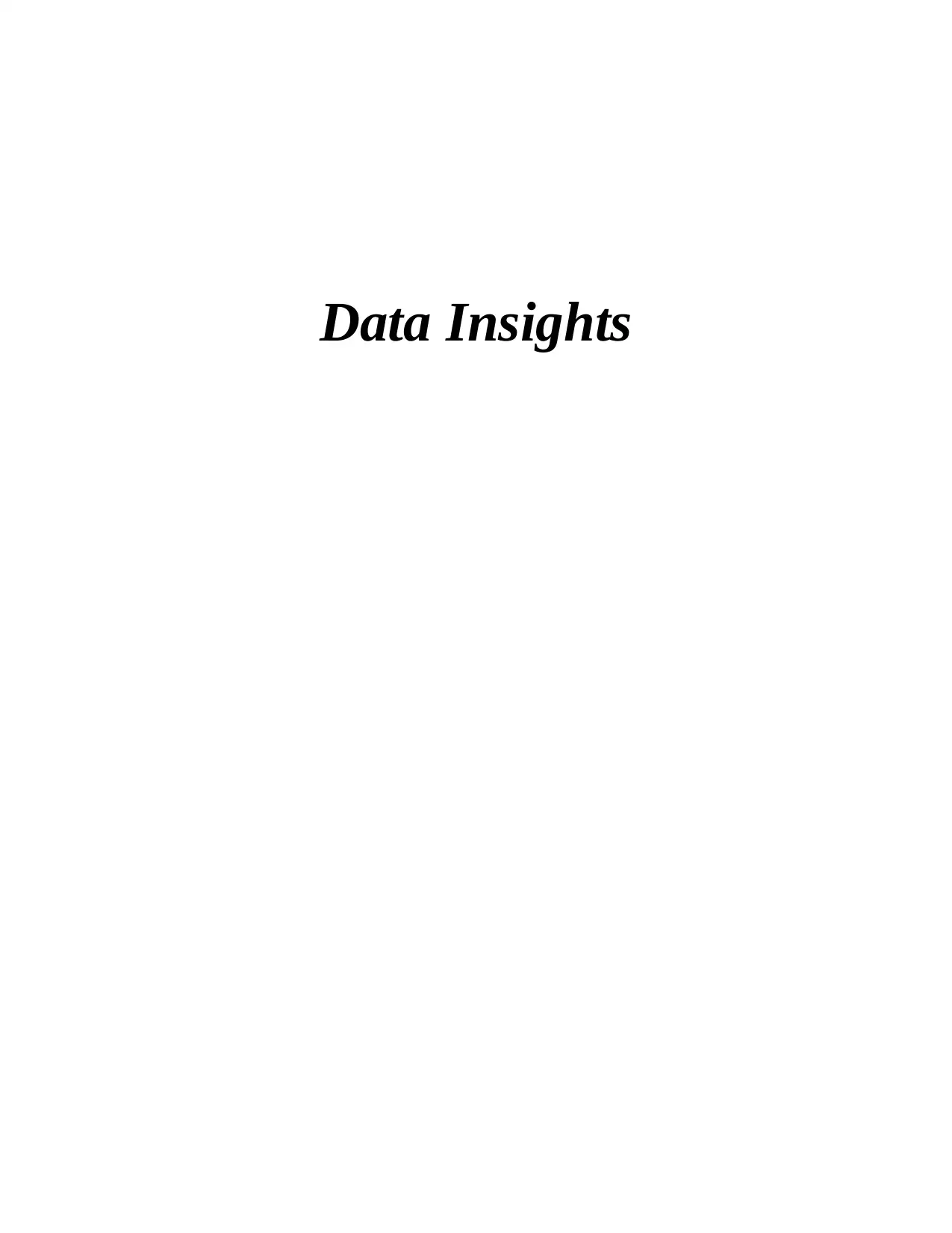
Data Insights
Paraphrase This Document
Need a fresh take? Get an instant paraphrase of this document with our AI Paraphraser
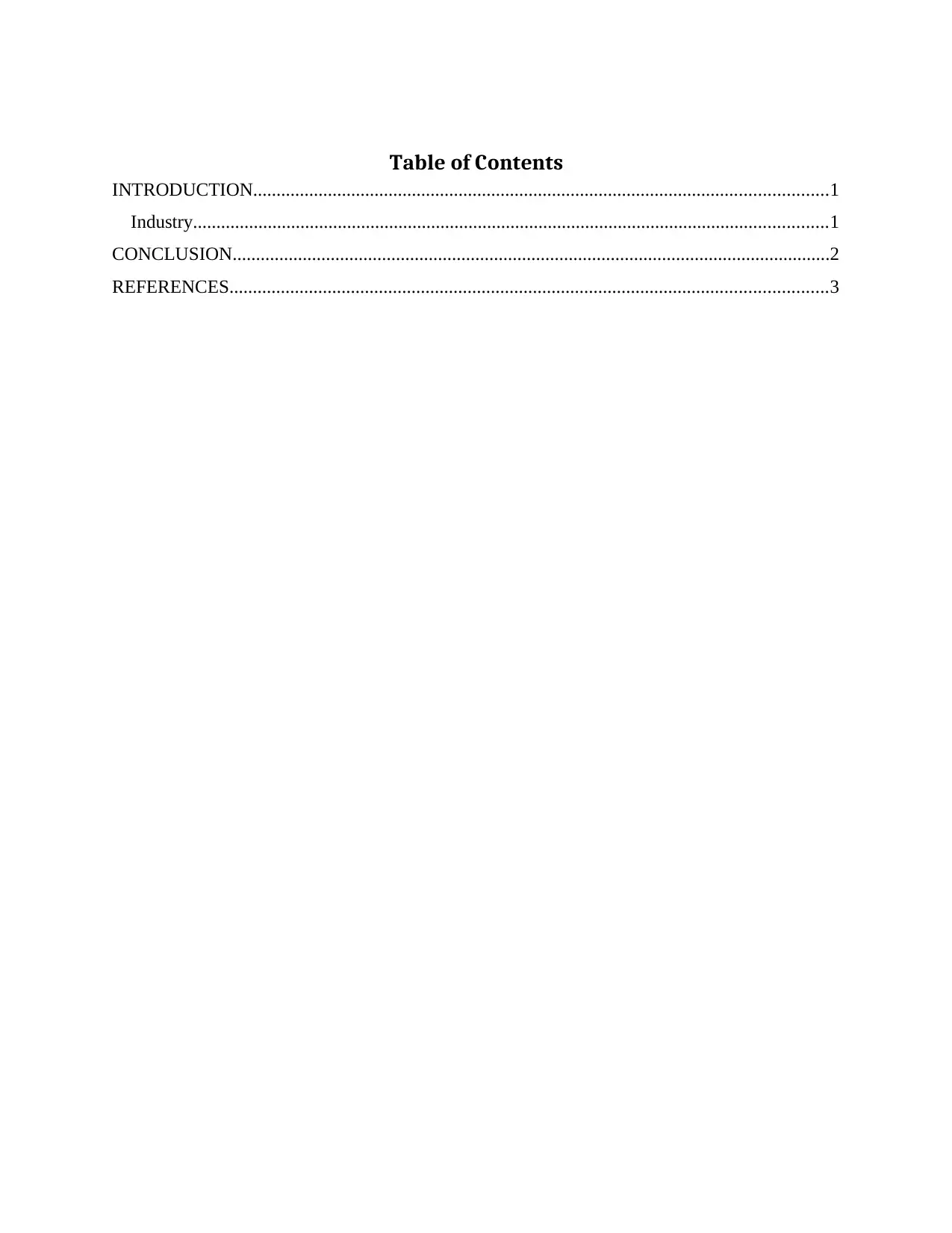
Table of Contents
INTRODUCTION...........................................................................................................................1
Industry........................................................................................................................................1
CONCLUSION................................................................................................................................2
REFERENCES................................................................................................................................3
INTRODUCTION...........................................................................................................................1
Industry........................................................................................................................................1
CONCLUSION................................................................................................................................2
REFERENCES................................................................................................................................3
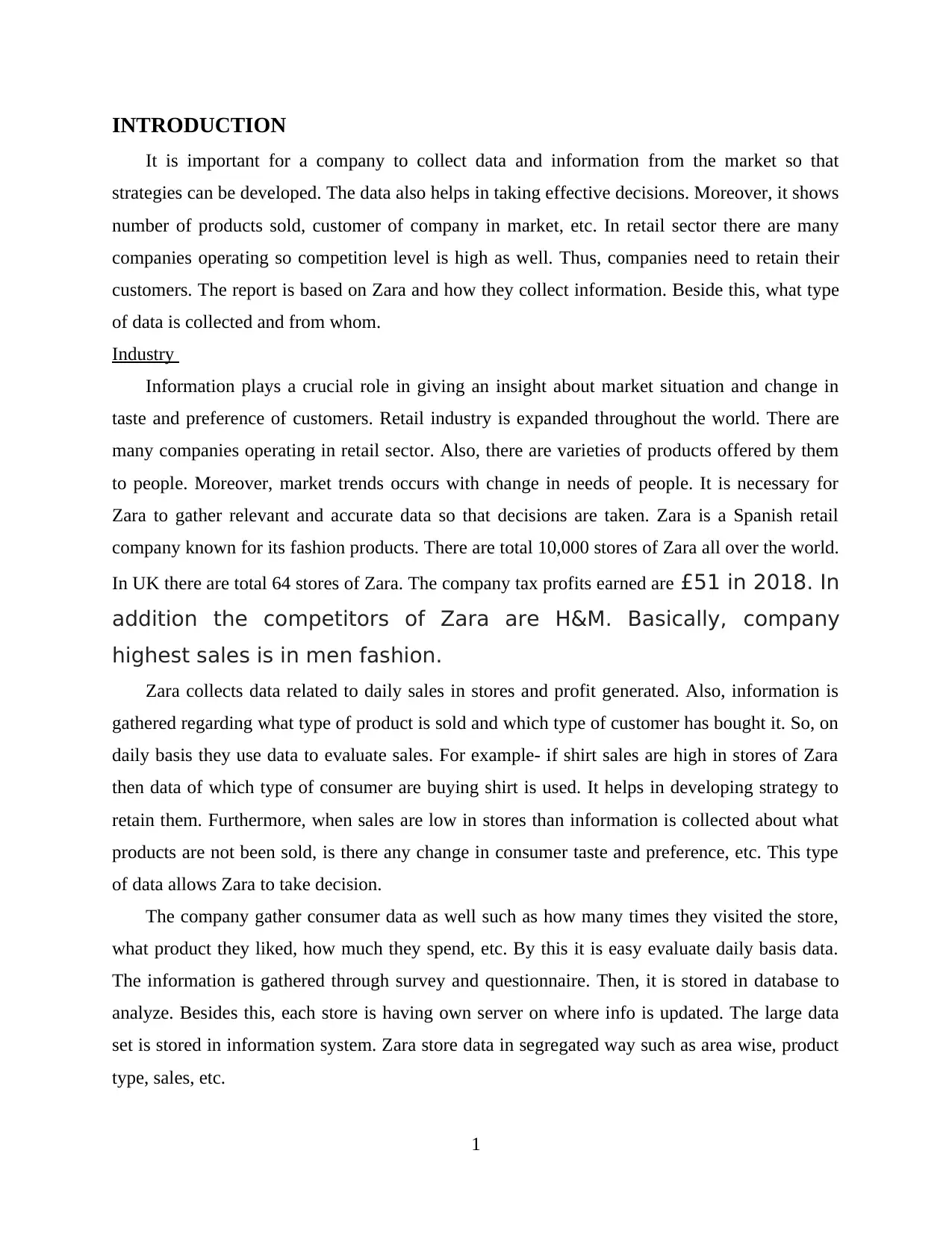
INTRODUCTION
It is important for a company to collect data and information from the market so that
strategies can be developed. The data also helps in taking effective decisions. Moreover, it shows
number of products sold, customer of company in market, etc. In retail sector there are many
companies operating so competition level is high as well. Thus, companies need to retain their
customers. The report is based on Zara and how they collect information. Beside this, what type
of data is collected and from whom.
Industry
Information plays a crucial role in giving an insight about market situation and change in
taste and preference of customers. Retail industry is expanded throughout the world. There are
many companies operating in retail sector. Also, there are varieties of products offered by them
to people. Moreover, market trends occurs with change in needs of people. It is necessary for
Zara to gather relevant and accurate data so that decisions are taken. Zara is a Spanish retail
company known for its fashion products. There are total 10,000 stores of Zara all over the world.
In UK there are total 64 stores of Zara. The company tax profits earned are £51 in 2018. In
addition the competitors of Zara are H&M. Basically, company
highest sales is in men fashion.
Zara collects data related to daily sales in stores and profit generated. Also, information is
gathered regarding what type of product is sold and which type of customer has bought it. So, on
daily basis they use data to evaluate sales. For example- if shirt sales are high in stores of Zara
then data of which type of consumer are buying shirt is used. It helps in developing strategy to
retain them. Furthermore, when sales are low in stores than information is collected about what
products are not been sold, is there any change in consumer taste and preference, etc. This type
of data allows Zara to take decision.
The company gather consumer data as well such as how many times they visited the store,
what product they liked, how much they spend, etc. By this it is easy evaluate daily basis data.
The information is gathered through survey and questionnaire. Then, it is stored in database to
analyze. Besides this, each store is having own server on where info is updated. The large data
set is stored in information system. Zara store data in segregated way such as area wise, product
type, sales, etc.
1
It is important for a company to collect data and information from the market so that
strategies can be developed. The data also helps in taking effective decisions. Moreover, it shows
number of products sold, customer of company in market, etc. In retail sector there are many
companies operating so competition level is high as well. Thus, companies need to retain their
customers. The report is based on Zara and how they collect information. Beside this, what type
of data is collected and from whom.
Industry
Information plays a crucial role in giving an insight about market situation and change in
taste and preference of customers. Retail industry is expanded throughout the world. There are
many companies operating in retail sector. Also, there are varieties of products offered by them
to people. Moreover, market trends occurs with change in needs of people. It is necessary for
Zara to gather relevant and accurate data so that decisions are taken. Zara is a Spanish retail
company known for its fashion products. There are total 10,000 stores of Zara all over the world.
In UK there are total 64 stores of Zara. The company tax profits earned are £51 in 2018. In
addition the competitors of Zara are H&M. Basically, company
highest sales is in men fashion.
Zara collects data related to daily sales in stores and profit generated. Also, information is
gathered regarding what type of product is sold and which type of customer has bought it. So, on
daily basis they use data to evaluate sales. For example- if shirt sales are high in stores of Zara
then data of which type of consumer are buying shirt is used. It helps in developing strategy to
retain them. Furthermore, when sales are low in stores than information is collected about what
products are not been sold, is there any change in consumer taste and preference, etc. This type
of data allows Zara to take decision.
The company gather consumer data as well such as how many times they visited the store,
what product they liked, how much they spend, etc. By this it is easy evaluate daily basis data.
The information is gathered through survey and questionnaire. Then, it is stored in database to
analyze. Besides this, each store is having own server on where info is updated. The large data
set is stored in information system. Zara store data in segregated way such as area wise, product
type, sales, etc.
1
⊘ This is a preview!⊘
Do you want full access?
Subscribe today to unlock all pages.

Trusted by 1+ million students worldwide
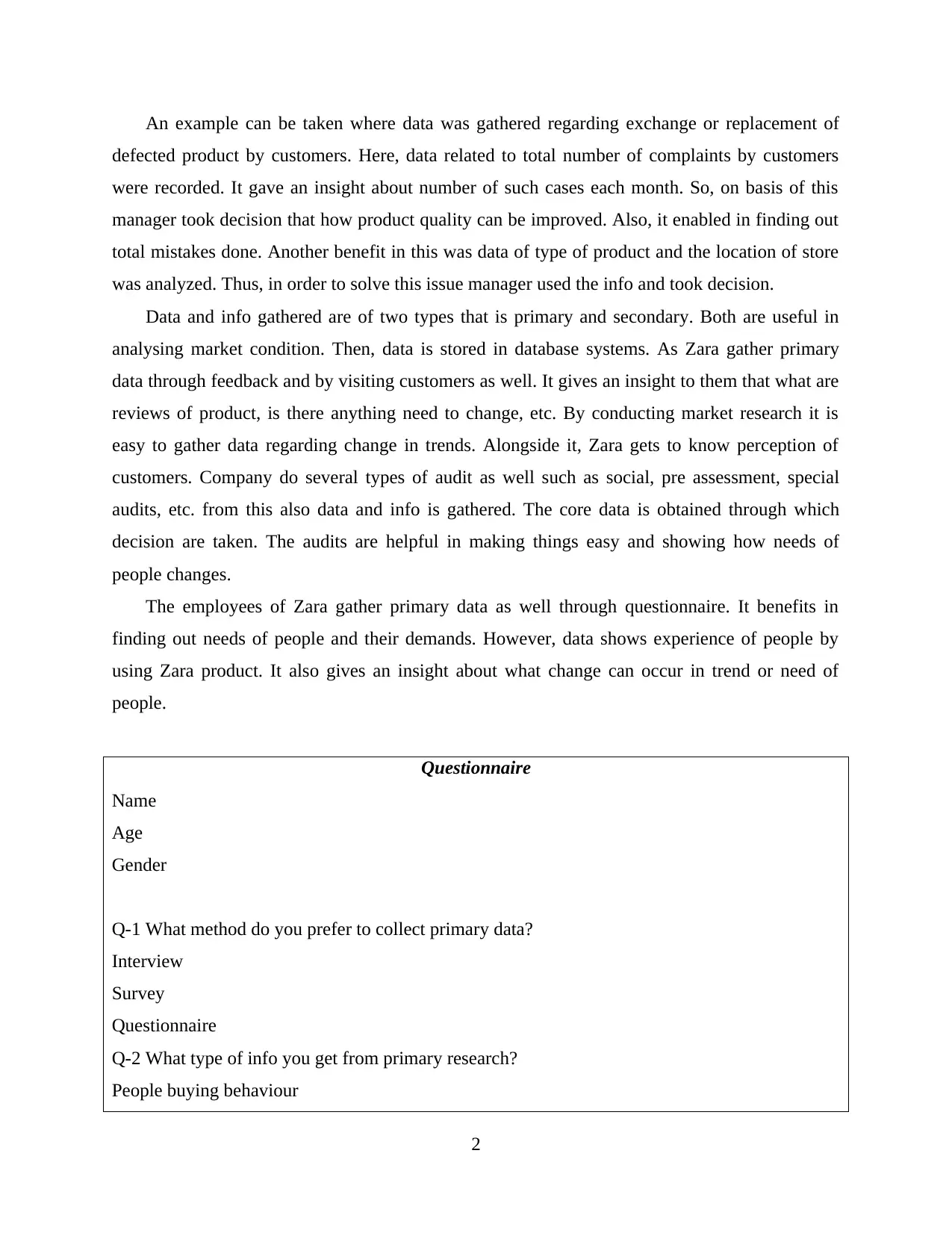
An example can be taken where data was gathered regarding exchange or replacement of
defected product by customers. Here, data related to total number of complaints by customers
were recorded. It gave an insight about number of such cases each month. So, on basis of this
manager took decision that how product quality can be improved. Also, it enabled in finding out
total mistakes done. Another benefit in this was data of type of product and the location of store
was analyzed. Thus, in order to solve this issue manager used the info and took decision.
Data and info gathered are of two types that is primary and secondary. Both are useful in
analysing market condition. Then, data is stored in database systems. As Zara gather primary
data through feedback and by visiting customers as well. It gives an insight to them that what are
reviews of product, is there anything need to change, etc. By conducting market research it is
easy to gather data regarding change in trends. Alongside it, Zara gets to know perception of
customers. Company do several types of audit as well such as social, pre assessment, special
audits, etc. from this also data and info is gathered. The core data is obtained through which
decision are taken. The audits are helpful in making things easy and showing how needs of
people changes.
The employees of Zara gather primary data as well through questionnaire. It benefits in
finding out needs of people and their demands. However, data shows experience of people by
using Zara product. It also gives an insight about what change can occur in trend or need of
people.
Questionnaire
Name
Age
Gender
Q-1 What method do you prefer to collect primary data?
Interview
Survey
Questionnaire
Q-2 What type of info you get from primary research?
People buying behaviour
2
defected product by customers. Here, data related to total number of complaints by customers
were recorded. It gave an insight about number of such cases each month. So, on basis of this
manager took decision that how product quality can be improved. Also, it enabled in finding out
total mistakes done. Another benefit in this was data of type of product and the location of store
was analyzed. Thus, in order to solve this issue manager used the info and took decision.
Data and info gathered are of two types that is primary and secondary. Both are useful in
analysing market condition. Then, data is stored in database systems. As Zara gather primary
data through feedback and by visiting customers as well. It gives an insight to them that what are
reviews of product, is there anything need to change, etc. By conducting market research it is
easy to gather data regarding change in trends. Alongside it, Zara gets to know perception of
customers. Company do several types of audit as well such as social, pre assessment, special
audits, etc. from this also data and info is gathered. The core data is obtained through which
decision are taken. The audits are helpful in making things easy and showing how needs of
people changes.
The employees of Zara gather primary data as well through questionnaire. It benefits in
finding out needs of people and their demands. However, data shows experience of people by
using Zara product. It also gives an insight about what change can occur in trend or need of
people.
Questionnaire
Name
Age
Gender
Q-1 What method do you prefer to collect primary data?
Interview
Survey
Questionnaire
Q-2 What type of info you get from primary research?
People buying behaviour
2
Paraphrase This Document
Need a fresh take? Get an instant paraphrase of this document with our AI Paraphraser
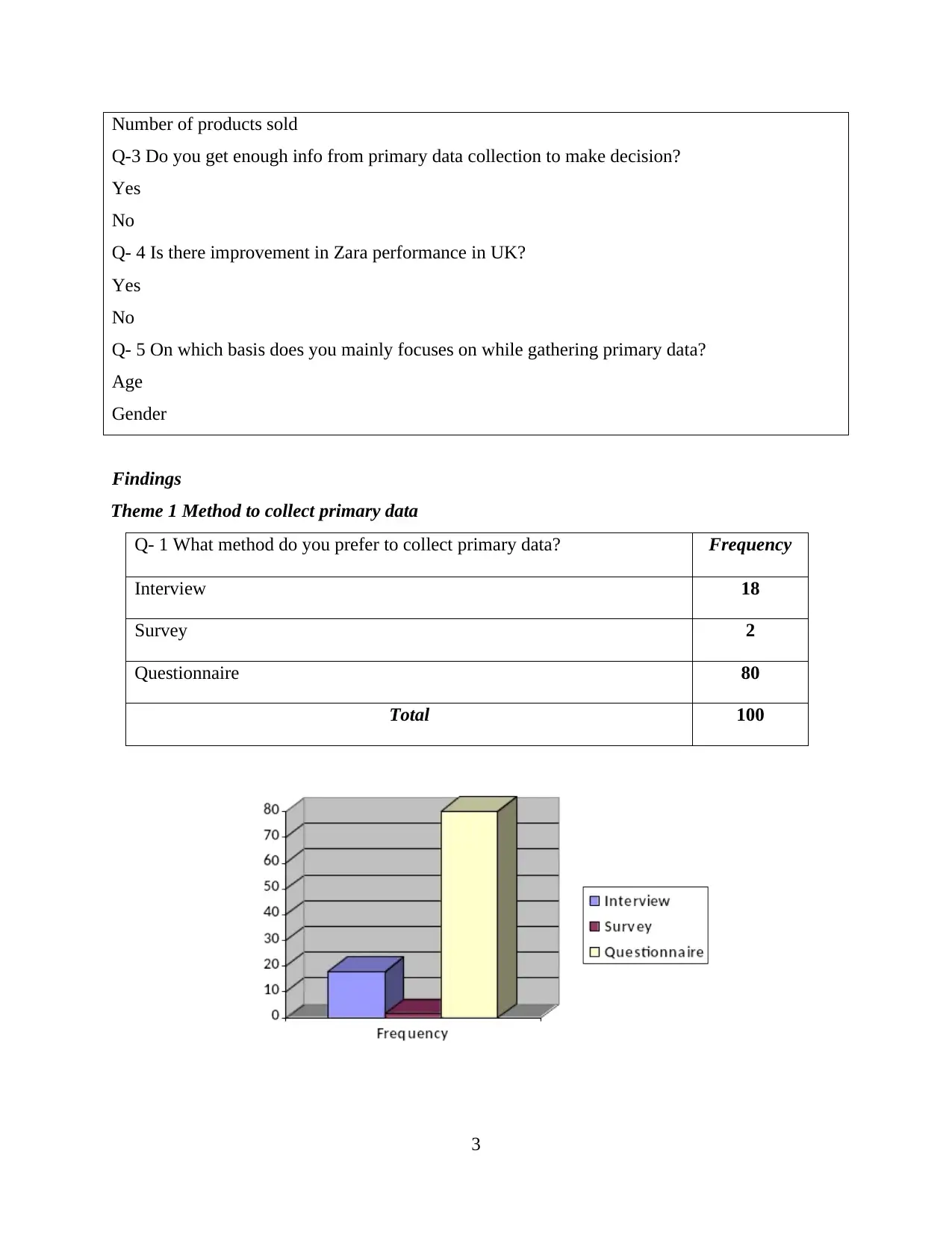
Number of products sold
Q-3 Do you get enough info from primary data collection to make decision?
Yes
No
Q- 4 Is there improvement in Zara performance in UK?
Yes
No
Q- 5 On which basis does you mainly focuses on while gathering primary data?
Age
Gender
Findings
Theme 1 Method to collect primary data
Q- 1 What method do you prefer to collect primary data? Frequency
Interview 18
Survey 2
Questionnaire 80
Total 100
3
Q-3 Do you get enough info from primary data collection to make decision?
Yes
No
Q- 4 Is there improvement in Zara performance in UK?
Yes
No
Q- 5 On which basis does you mainly focuses on while gathering primary data?
Age
Gender
Findings
Theme 1 Method to collect primary data
Q- 1 What method do you prefer to collect primary data? Frequency
Interview 18
Survey 2
Questionnaire 80
Total 100
3
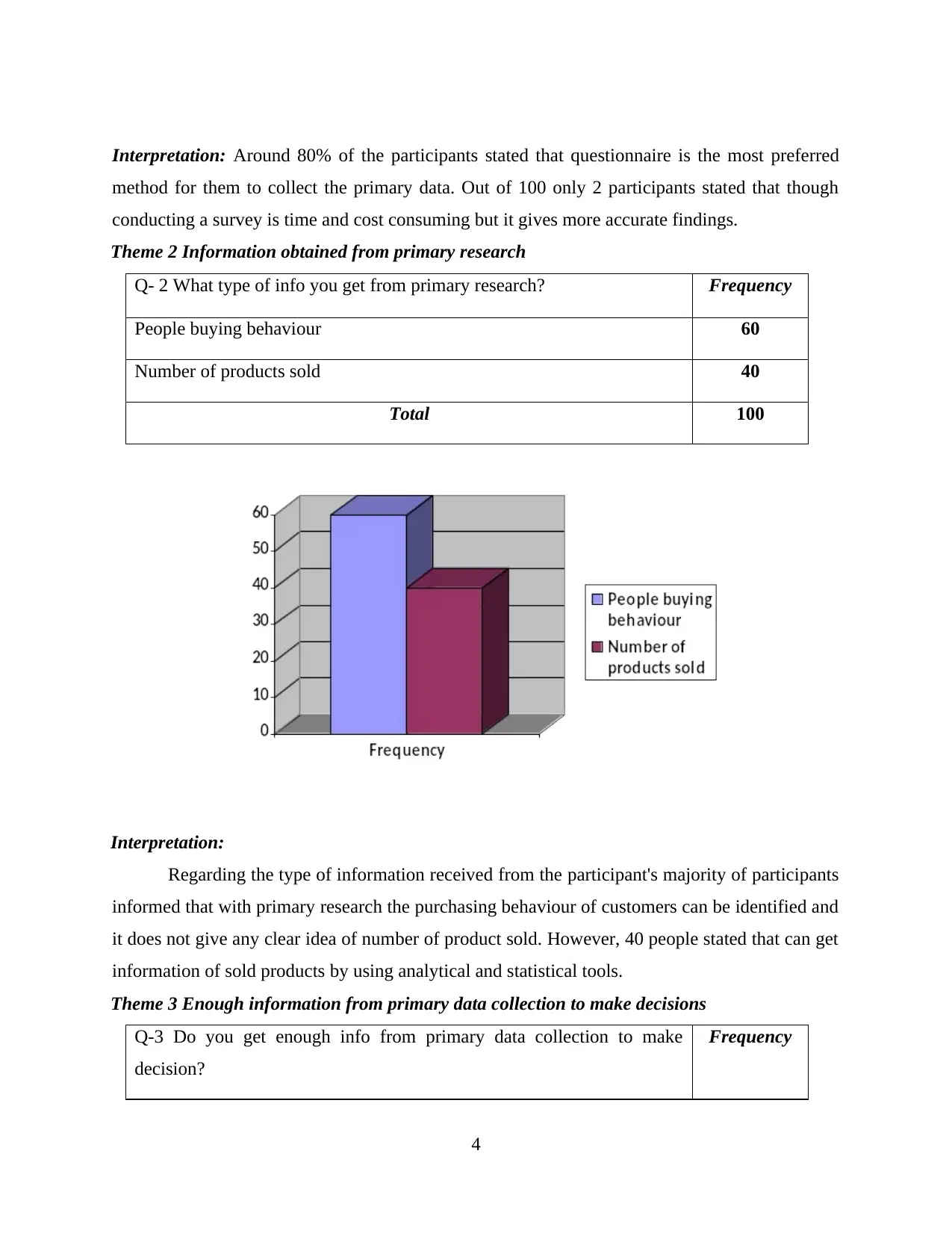
Interpretation: Around 80% of the participants stated that questionnaire is the most preferred
method for them to collect the primary data. Out of 100 only 2 participants stated that though
conducting a survey is time and cost consuming but it gives more accurate findings.
Theme 2 Information obtained from primary research
Q- 2 What type of info you get from primary research? Frequency
People buying behaviour 60
Number of products sold 40
Total 100
Interpretation:
Regarding the type of information received from the participant's majority of participants
informed that with primary research the purchasing behaviour of customers can be identified and
it does not give any clear idea of number of product sold. However, 40 people stated that can get
information of sold products by using analytical and statistical tools.
Theme 3 Enough information from primary data collection to make decisions
Q-3 Do you get enough info from primary data collection to make
decision?
Frequency
4
method for them to collect the primary data. Out of 100 only 2 participants stated that though
conducting a survey is time and cost consuming but it gives more accurate findings.
Theme 2 Information obtained from primary research
Q- 2 What type of info you get from primary research? Frequency
People buying behaviour 60
Number of products sold 40
Total 100
Interpretation:
Regarding the type of information received from the participant's majority of participants
informed that with primary research the purchasing behaviour of customers can be identified and
it does not give any clear idea of number of product sold. However, 40 people stated that can get
information of sold products by using analytical and statistical tools.
Theme 3 Enough information from primary data collection to make decisions
Q-3 Do you get enough info from primary data collection to make
decision?
Frequency
4
⊘ This is a preview!⊘
Do you want full access?
Subscribe today to unlock all pages.

Trusted by 1+ million students worldwide
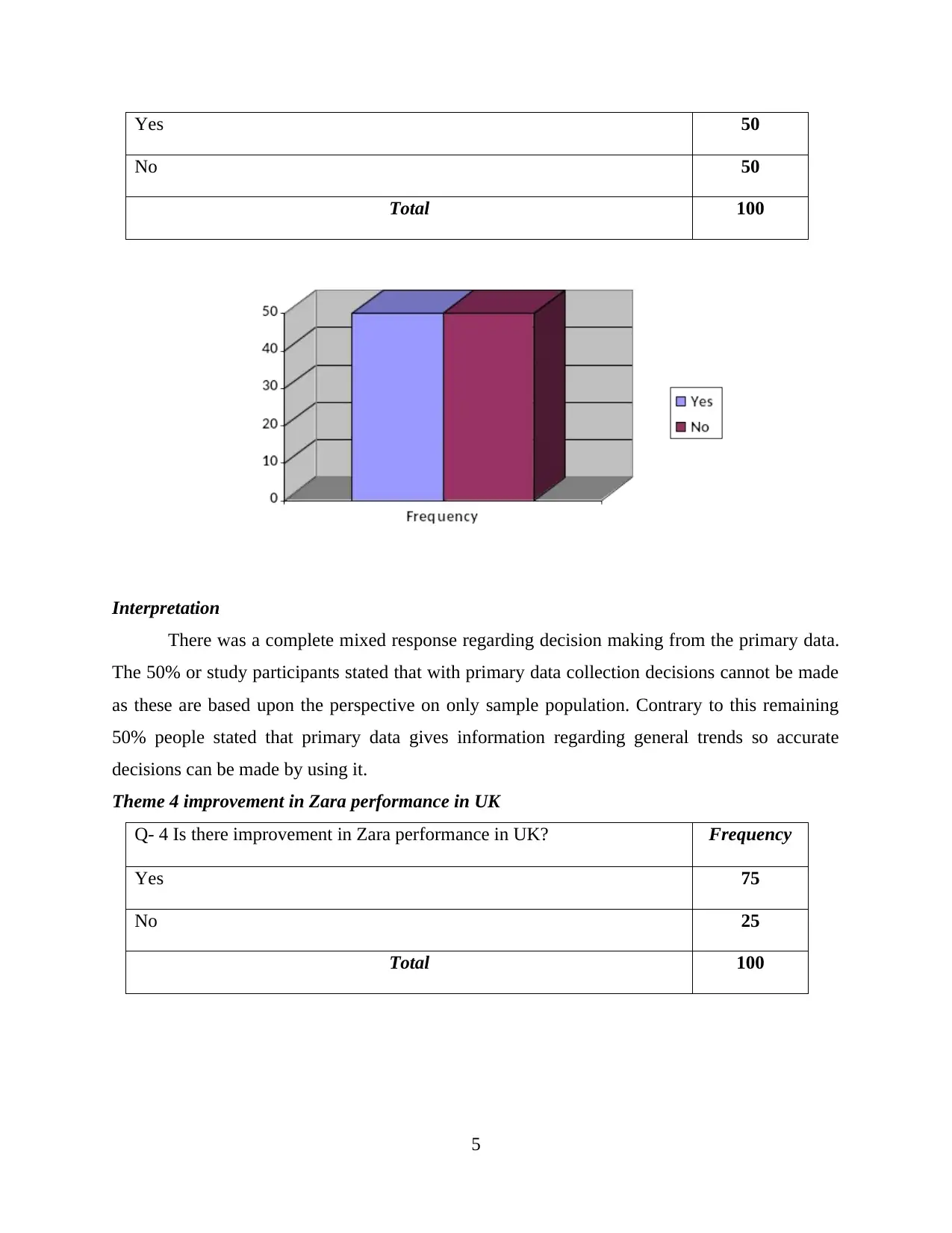
Yes 50
No 50
Total 100
Interpretation
There was a complete mixed response regarding decision making from the primary data.
The 50% or study participants stated that with primary data collection decisions cannot be made
as these are based upon the perspective on only sample population. Contrary to this remaining
50% people stated that primary data gives information regarding general trends so accurate
decisions can be made by using it.
Theme 4 improvement in Zara performance in UK
Q- 4 Is there improvement in Zara performance in UK? Frequency
Yes 75
No 25
Total 100
5
No 50
Total 100
Interpretation
There was a complete mixed response regarding decision making from the primary data.
The 50% or study participants stated that with primary data collection decisions cannot be made
as these are based upon the perspective on only sample population. Contrary to this remaining
50% people stated that primary data gives information regarding general trends so accurate
decisions can be made by using it.
Theme 4 improvement in Zara performance in UK
Q- 4 Is there improvement in Zara performance in UK? Frequency
Yes 75
No 25
Total 100
5
Paraphrase This Document
Need a fresh take? Get an instant paraphrase of this document with our AI Paraphraser
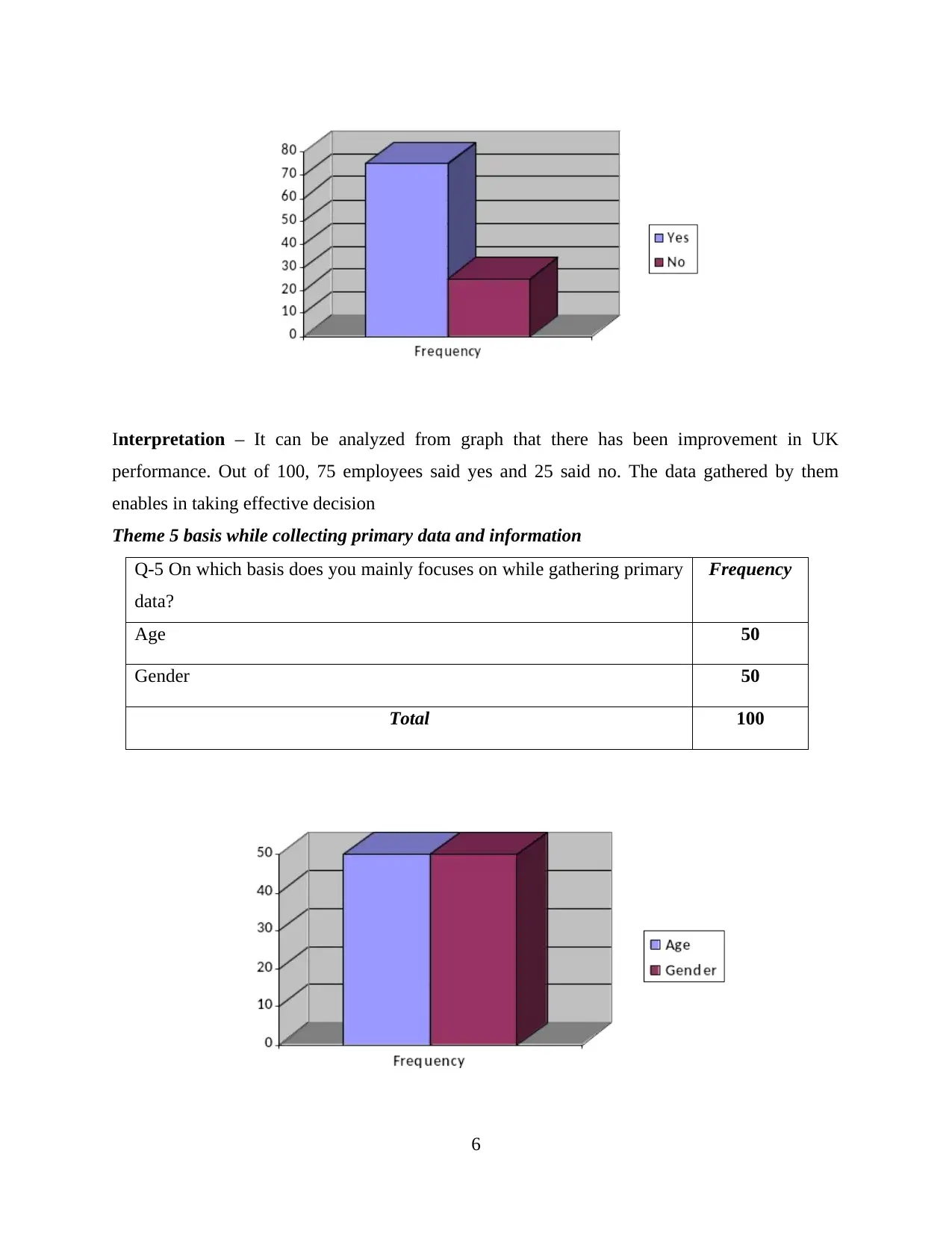
Interpretation – It can be analyzed from graph that there has been improvement in UK
performance. Out of 100, 75 employees said yes and 25 said no. The data gathered by them
enables in taking effective decision
Theme 5 basis while collecting primary data and information
Q-5 On which basis does you mainly focuses on while gathering primary
data?
Frequency
Age 50
Gender 50
Total 100
6
performance. Out of 100, 75 employees said yes and 25 said no. The data gathered by them
enables in taking effective decision
Theme 5 basis while collecting primary data and information
Q-5 On which basis does you mainly focuses on while gathering primary
data?
Frequency
Age 50
Gender 50
Total 100
6
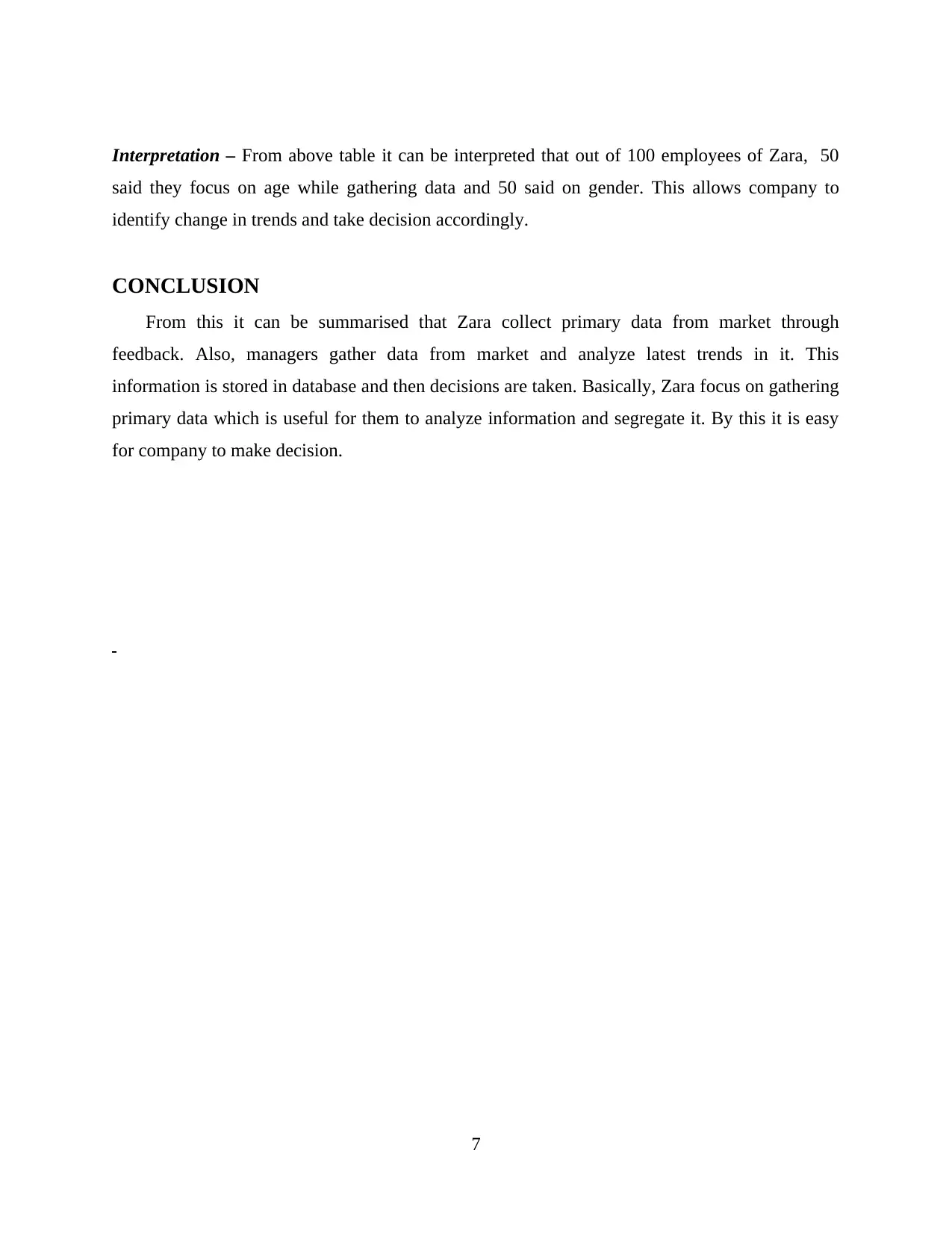
Interpretation – From above table it can be interpreted that out of 100 employees of Zara, 50
said they focus on age while gathering data and 50 said on gender. This allows company to
identify change in trends and take decision accordingly.
CONCLUSION
From this it can be summarised that Zara collect primary data from market through
feedback. Also, managers gather data from market and analyze latest trends in it. This
information is stored in database and then decisions are taken. Basically, Zara focus on gathering
primary data which is useful for them to analyze information and segregate it. By this it is easy
for company to make decision.
7
said they focus on age while gathering data and 50 said on gender. This allows company to
identify change in trends and take decision accordingly.
CONCLUSION
From this it can be summarised that Zara collect primary data from market through
feedback. Also, managers gather data from market and analyze latest trends in it. This
information is stored in database and then decisions are taken. Basically, Zara focus on gathering
primary data which is useful for them to analyze information and segregate it. By this it is easy
for company to make decision.
7
⊘ This is a preview!⊘
Do you want full access?
Subscribe today to unlock all pages.

Trusted by 1+ million students worldwide
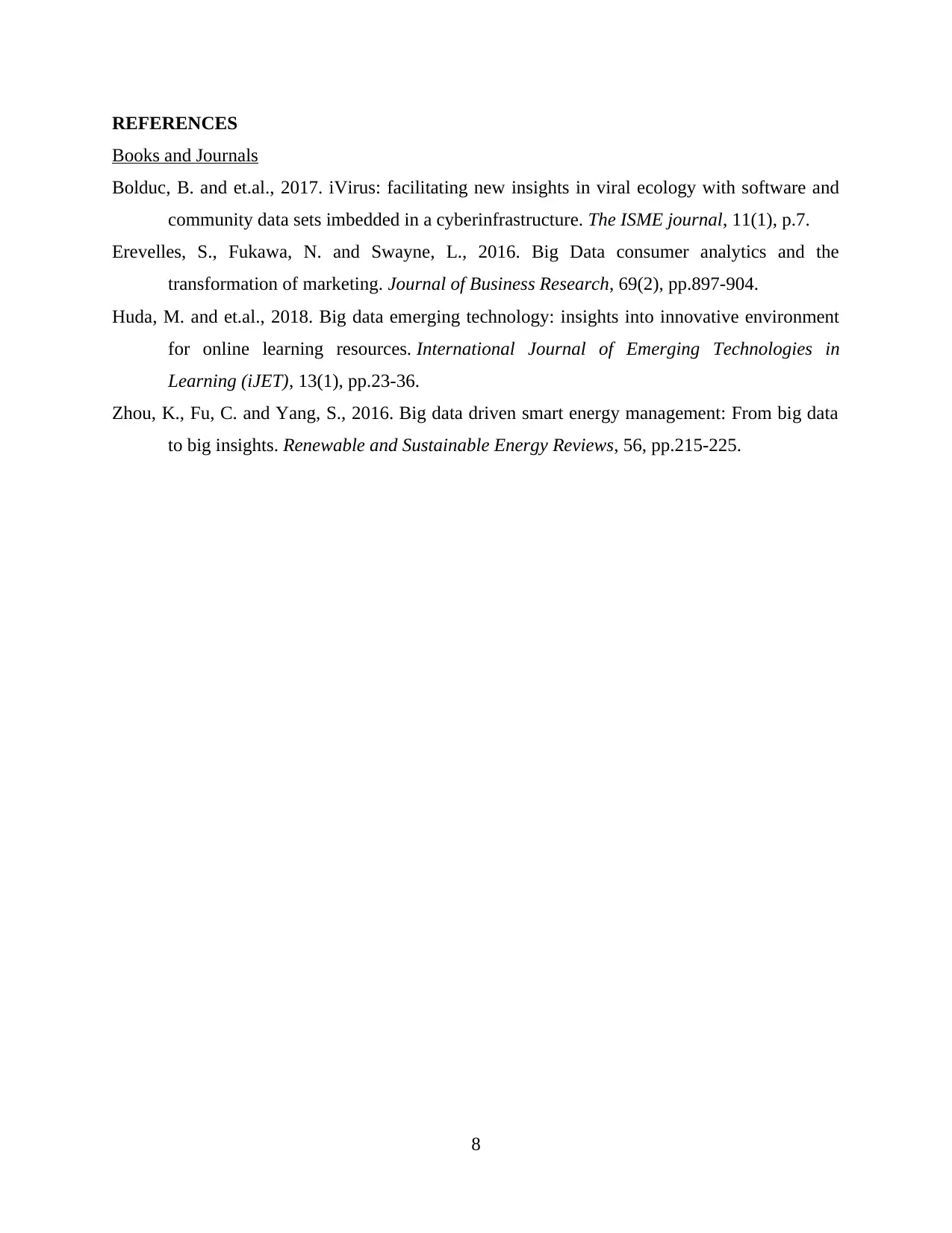
REFERENCES
Books and Journals
Bolduc, B. and et.al., 2017. iVirus: facilitating new insights in viral ecology with software and
community data sets imbedded in a cyberinfrastructure. The ISME journal, 11(1), p.7.
Erevelles, S., Fukawa, N. and Swayne, L., 2016. Big Data consumer analytics and the
transformation of marketing. Journal of Business Research, 69(2), pp.897-904.
Huda, M. and et.al., 2018. Big data emerging technology: insights into innovative environment
for online learning resources. International Journal of Emerging Technologies in
Learning (iJET), 13(1), pp.23-36.
Zhou, K., Fu, C. and Yang, S., 2016. Big data driven smart energy management: From big data
to big insights. Renewable and Sustainable Energy Reviews, 56, pp.215-225.
8
Books and Journals
Bolduc, B. and et.al., 2017. iVirus: facilitating new insights in viral ecology with software and
community data sets imbedded in a cyberinfrastructure. The ISME journal, 11(1), p.7.
Erevelles, S., Fukawa, N. and Swayne, L., 2016. Big Data consumer analytics and the
transformation of marketing. Journal of Business Research, 69(2), pp.897-904.
Huda, M. and et.al., 2018. Big data emerging technology: insights into innovative environment
for online learning resources. International Journal of Emerging Technologies in
Learning (iJET), 13(1), pp.23-36.
Zhou, K., Fu, C. and Yang, S., 2016. Big data driven smart energy management: From big data
to big insights. Renewable and Sustainable Energy Reviews, 56, pp.215-225.
8
1 out of 10
Related Documents
Your All-in-One AI-Powered Toolkit for Academic Success.
+13062052269
info@desklib.com
Available 24*7 on WhatsApp / Email
![[object Object]](/_next/static/media/star-bottom.7253800d.svg)
Unlock your academic potential
Copyright © 2020–2025 A2Z Services. All Rights Reserved. Developed and managed by ZUCOL.





